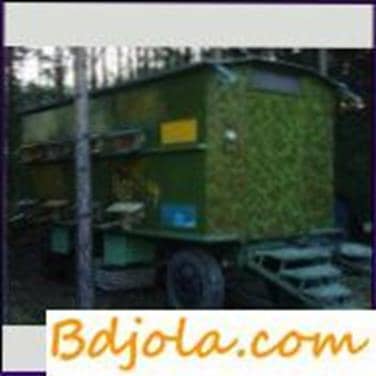
Being engaged in the pavilion content of bees, I regularly get acquainted with the relevant literature. I carefully read all the materials published on the pavilion content of bees in Siberia, the article frankly surprised. The author writes: “I came to the conclusion that in our conditions the pavilion content is impossible, although very tempting.” What are his arguments?
“In the winter, 12 families left, but only eight survived.”
“All the summer I lived in the pavilion and watched the bees… During the day the pavilion heated up and the bees could not fly for a bribe, since most of them ventilated the hive.” During the night the pavilion drastically cooled and the bees were forced to warm the brood… A sharp temperature drop adversely affected the development of families. “
Well, all this, apparently, took place because the author only “observed the bees,” but it was necessary to work with them and give them all kinds of help.
In absentia it is difficult to judge what the pavilion is, since it does not give its description, but only mentions that it “has planks on all sides”. Of course, such a pavilion should warm up during the day. It was necessary to insulate it. To bees flying for nectar, and not “ventilated hive”, it is necessary to ensure the normal ventilation of the pavilion and hives. And in order for the pavilion not to “cool down” at night, you need to have a large internal volume in addition to the insulation. Then there will not be a sharp temperature drop. By the way, the diurnal temperature difference in the Altai Territory is much less than in Perm Region.
Successfully engaged in pavilion beekeeping, except Perm, in the Sverdlovsk and Leningrad regions, the Krasnoyarsk Territory and other regions where the climatic conditions are similar to the Altai Territory and even worse.
I do not think there is any reason to link the death of four families to the pavilion, there are other possible reasons. It is unlikely that because of their failures, the possibility of pavilion beekeeping in Siberia should be denied.
I keep my bees in a mobile pavilion with an area of 2X3 m2. Its internal height is 1.9 m. The walls of the pavilion consist of boards of 20 mm thick, covered with pergamon (waterproofing) and two layers of hardboard. The total thickness of the walls is 50 mm.
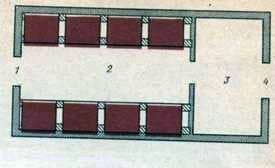
Fig. I. Scheme of the pavilion.
Inside, they are covered with wallpaper. In the back wall there is an entrance door 1, and in the front there is a window 4. In the ceiling the hatch is 60X60 cm in size (not shown in the figure). Multi-hull beehives with frames on a warm skid are located along the walls. The width of the aisle 1 between them is 90 cm. In the front part of the pavilion there is the room of the beekeeper 3 (900X2000 mm) with a folding table and a folding trestle. To make it easier to inspect the nests, there is a free space 3 in the hive compartments of the pavilion between the nest corps 2 and the hulls with the sushi and wax 4, the thickness of the front walls of the hives 35, and together with the walls of the pavilion – 85 mm, which protects the nests from overheating. The hives have a detachable bottom 1 and a retractable mesh subframe. The height of the frame is 130 mm.
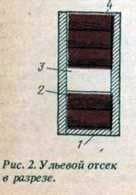
In the walls of the pavilion, slotted cracks are cut to which beehives are placed. I use the chain hoist for lifting the hulls.
When the families occupy two buildings, I partition them with a dividing grid. From above I put the third with a land and a wax (I expand nests only by cases). In it and the subsequent buildings there is no brood, so it is very convenient to take honey away from the buildings.
During the honey collection carefully monitor the appearance of the injection in the upper housing. If at least on one frame there will be an injection of the size of a palm, I put the next body. I’m not afraid of cooling nests, because I’m doing it in a warm time. If a sudden cold snap occurs (this happens to us), then a part of the bees will descend to lower the brood from the upper hulls to the lower ones.
I constantly care about ventilation of the pavilion and hives. In hot weather I open either a door, or a window, or a ceiling hatch, and if necessary all at once. Therefore, the temperature inside the pavilion never rises above the outside. At night, when the door – the window and hatch are closed, the pavilion warmed up for the day cools down gradually, and the diurnal temperature drop practically does not affect the bees.
If the bees begin to ventilate the nests, I fully open all three lower vents that are located between the bottom and the first hull, between the second and third, and between the fourth and fifth hulls. If necessary, open the rear valves of the donkeys and even wedge the body. Bees are released from ventilation of hives, actively fly for nectar.
A question may arise: what is the effectiveness of such beekeeping? I will give an example. In 1988, I fell ill and could not deal with bees. In the spring I had only one weak family. In early June, I bought two four-bag packages, the family had eight frames of brood. One of the packages was strengthened by three frames of mature brood. Thus, the two families turned out to be equal in strength. In August, each of the three families received on average 50 kg of marketable honey, and left at least 30 kg of feed in the nests. And this is without nomadic. Some beekeepers, whose apiaries were located near my pavilion, on average took no more than 10 kg of marketable honey. In less favorable years I received from the family a jar of honey and more. Since 1984, I have not lost any family in the pavilion (and the bees in it and winter).
As they used to say in the old days: “You can not wiggle even a bastard”. Let the reader judge for himself whether it is possible to engage in pavilion beekeeping in the conditions of the Urals and Siberia. Perhaps my experience will be useful to beekeepers.
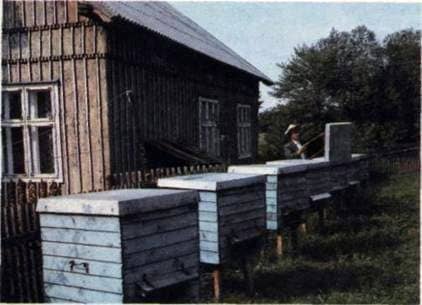
Continuous non-pecked periods between the flowering of white acacia and sunflower – the main honeycomb – do not contribute to the normal conduct of beekeeping.
Since homestead beekeeping is based mainly on crops of intensive farming (sunflower, ether-oil, vegetable-melon, fodder crops, fruit and berry plantings), an apiary without a nomad is unprofitable. And it is not surprising that over 30 pavilions and platforms that are recommended by our regional society of beekeepers roam the steppes.
In particular, an excellent pavilion was built by the beekeeper. The construction is biaxial, transported by the car “Niva”, fully meets the traffic police requirements for one-time traffic in rural areas. The pavilion with twenty hives weighs 1500 kg. Beehives 18-frame with a magazine extension on the half-frame with a partition for the bivouac-keeping of bees in winter: circular rounds, working and technological completely eliminate bee-stealing, and unproductive uteruses from the matrimonial flight return to their hive.
A special device around the tap prevents the flying of bees. The cost of maintaining the pavilion pays for the season.
In the region the flowering period of the main honey-plants is determined, which helps the beekeepers to make plans for migrations. For 3 years, an average of 45-50 kg of marketable honey was received from the family. This is due to the retention in the apiaries of only strong families, as well as the annual replacement of almost half of the queens. Many lovers hold in the hive two uterus, one of whom is an assistant, which gives an opportunity to complete the growth of families by the beginning of May. With the growth of young families in winter, the old uterus also takes part in increasing the number of so-called winter bees and at the end of October the families become strong and full-fledged, they tolerate wintering well with a small amount of detritus.
The dimensions of the pavilion (in meters): length – 3.9, width – 1.9, height – 1.8. In both end walls there is a door 3. Floor 4 with covered linoleum of plywood. The walls are double with a fiberboard with a 30-mm gap between them. The pavilion has a passage 900 mm wide. To protect the walls from the rain and sun over them are equipped with peaks 6. For ventilation on the road, the upper part of the roof 1 rises with a winch. Beehive lounger 2 with a partition for the two-family maintenance of bees in winter has 18 frames with an extension on the half-frame. In the niche are arranged guide rollers, which makes it easier to roll out the hives on the passage of the pavilion and again into the nest.
Working chute 7, 100 mm long and technological – length 600 mm, is a continuation of the hive hive and ensures normal operation when inspecting the bees on the aisle. The landing board is fixed on the canopies to the outside of the pavilion. Sanitary box 5 serves to combat varroatosis.
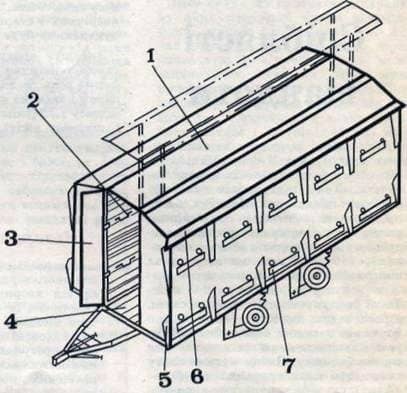
The technology of conducting works does not differ from the care of bees in the hospital.
In the spring after the flight, sanitary pallets are cleaned from the debris, garbage and dead varroa mites, creating the necessary conditions for the rapid development of young bees. In the pavilion, families develop a week earlier than usual. Before leaving for acacia, one uterus on five frames with a different age brood is transferred to another hive, it develops well and is ready to bribe from sunflower. The main united family with 10-12 frames of closed brood ready for honey picking from acacia and sainfoin, then an extension is placed on the frame, which creates a permanent working condition of the family.
Pump honey in a special tent, where the full-medial frames and extensions are transferred. In return, a land or an artificial wax is put. Uterus continuously lays eggs for 1500 pcs. in day, and bees actively restore a wax.
In the pavilion simultaneously work with two hives one at a time from each door. After pumping honey in August, families are united for winter into a two-family hive. For the full coverage of all the honey plants, an average of eight shipments per season.
Чем отличается перга от пыльцы. Обычный медовик.
Pasechnye buildings